
Educational Activities, Toys, and all things STEM

Vinegar and Baking Soda Reaction Experiments
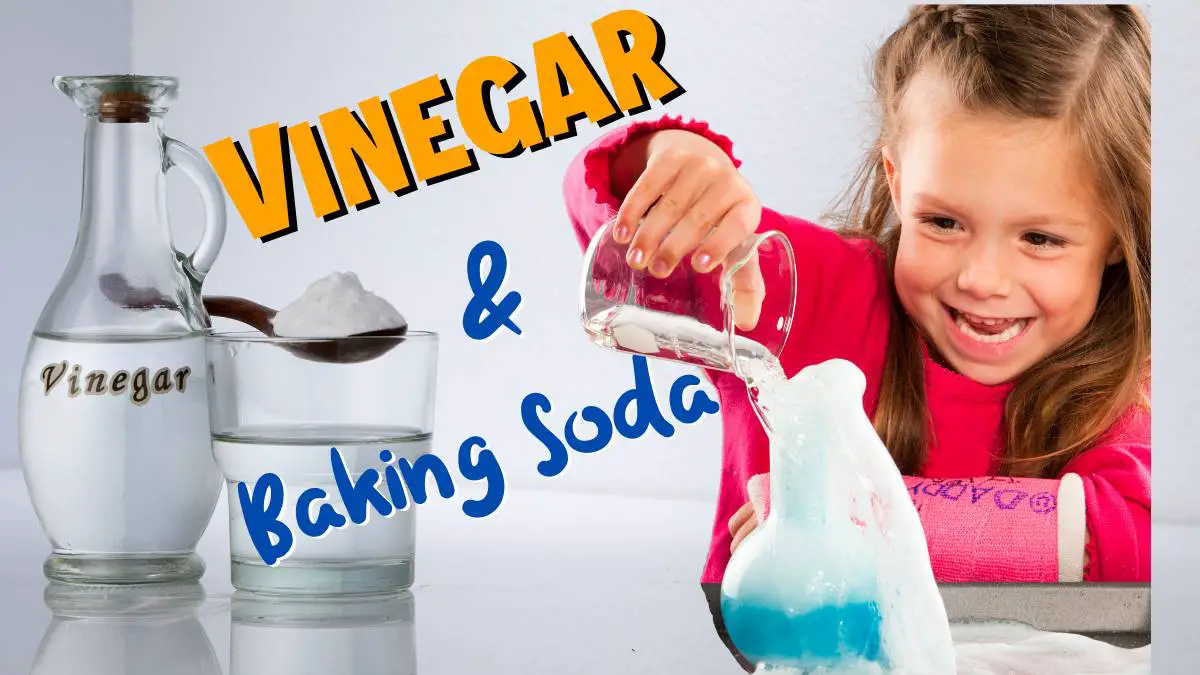
*We’re an affiliate – we may earn a commission through qualifying purchases from the links on this page. As always, thanks!*
From creating bubbling volcanoes to exploring the properties of acids and bases, vinegar and baking soda offer fun opportunities for hands-on learning and experimentation.
So grab a bottle of vinegar and a box of baking soda, and get ready to have some fun! We’ll explore some of the many experiments and activities you can do with these two versatile ingredients. Get ready to be amazed by the science behind the fizz!
The Science and Chemistry of Vinegar and Baking Soda
The reaction between vinegar and baking soda is often used in science experiments to demonstrate chemical reactions or to create a gas that can be used to inflate a balloon or make a homemade volcano. It’s a simple and fun way to explore chemistry and learn about the properties of acids and bases., and we’ve done experiments with this chemical reaction a bunch of times.
Okay, that’s great and all – we know it ‘s a safe experiment that make a fizzy reaction. What’s actually happening? What’s the science behind simply combining these two ingredients?
The reaction between vinegar and baking soda is a classic chemistry demonstration that produces carbon dioxide gas. When vinegar and baking soda are mixed together, the acidity of the vinegar reacts with the basic nature of the baking soda to produce a chemical reaction. The reaction produces carbon dioxide gas, which causes the mixture to bubble and foam. In this case, the acid is the vinegar (acetic acid) and the base is the baking soda (sodium bicarbonate). The salt produced in the reaction is sodium acetate, and the water is produced as a byproduct of the reaction. Here are the compounds involved:
- CH3COOH: acetic acid (vinegar)
- NaHCO3: sodium bicarbonate (baking soda)
- CH3COONa: sodium acetate
- CO2: carbon dioxide gas
The chemical equation for combining vinegar (acetic acid) and baking soda (sodium bicarbonate) is:
CH3COOH + NaHCO3 → CH3COONa + H2O + CO2
This reaction produces water, carbon dioxide gas, and sodium acetate (CH3COONa). This produces carbon dioxide bubbles, as the production of carbon dioxide gas is what gives the mixture its characteristic fizzing and bubbling. The overall reaction can be written as an acid-base reaction, with the acetic acid (vinegar) acting as the acid and the baking soda acting as the base.
Activities with Vinegar and Baking Soda
The kids always enjoy seeing the foam fizz up. We usually need to do it multiple times so they each get a turn pouring in the vinegar.
Remember to have some paper towels or rags on hand! You can do what you can to try and contain the fizz and the mess, but always expect to be wiping up and prepare before you start mixing.
Make a Volcano
This is the classic experiment everyone thinks of with vinegar and baking soda. It’s the go to experiment for good reasons:
- It’s quick and easy to do
- It doesn’t involve harsh chemicals
- It uses common kitchen ingredients
- It’s very visual
Place a small amount of baking soda and a paper cup or small glass (many science experiment or STEM kits include a plastic volcano specifically for this experiment.) In a separate cup or glass, add a few drops of red food coloring and some vinegar. Slowly pour vinegar over the baking soda. Watch as the mixture fizzes and bubbles, creating a “volcano” effect.
The exact amount isn’t vital, though you can use a 1:1 ratio (equal parts of each) for a starting point. So, mixing 2 tablespoons of vinegar with 2 tablespoons of baking soda will give you a good reaction. The more of both you uses, the bigger the reaction will be!
Apple Volcano
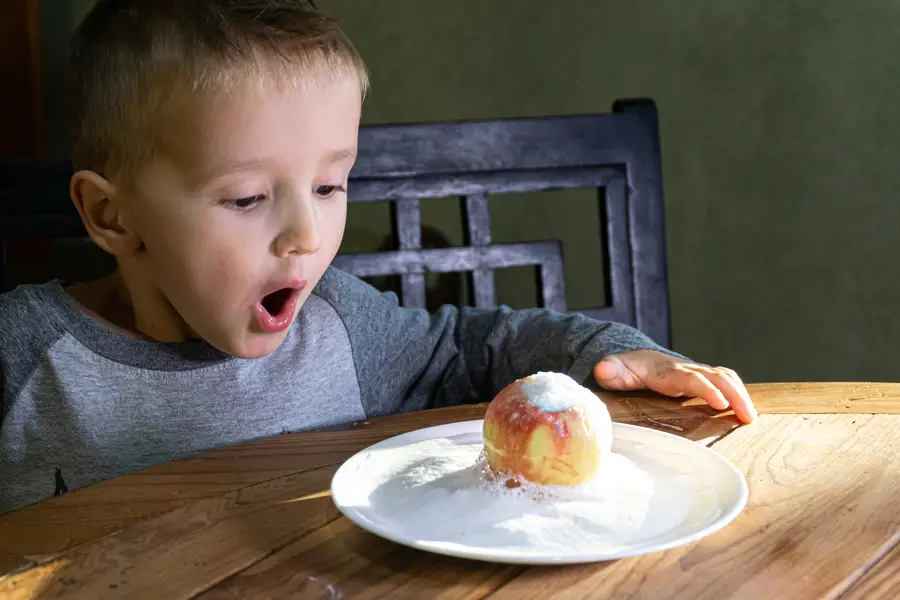
During our experiments with apples , we cored out an apple to use as a variation of the classic volcano. We placed the baking soda in the apple and poured the vinegar over it.
Create a fizzy reaction
You don’t always have to make a volcano. Just mixing equal parts vinegar and baking soda in a small container will still provide the same demonstration. Observe the fizzing and bubbling that occurs as the two substances react.
Try adding a few drops of food coloring for different effects or occasions! Green bubbling cauldrons are great for Halloween!
Inflate a Balloon
Most people fixate on the fizz and foam created when doing this experiment. The byproduct of the vinegar solution is carbon dioxide gas, which is invisible. By sealing the reaction in a closed space, we can “see” the results as the balloon gets inflated. Check it out in our experiments with plastic bottles .
Pro tip: make sure your balloon doesn’t have a hole in it!
Vinegar and Baking Soda Rocket Fuel
If you tried the experiment to inflate a balloon, you saw how the byproduct gas expands and inflates the balloon. What if there was no where for the gas to expand? It’d create increased pressure in a confined space until it stopped expanding – or it’d build up enough pressure to expand further.
We can use that pressure (and release) as rocket fuel!
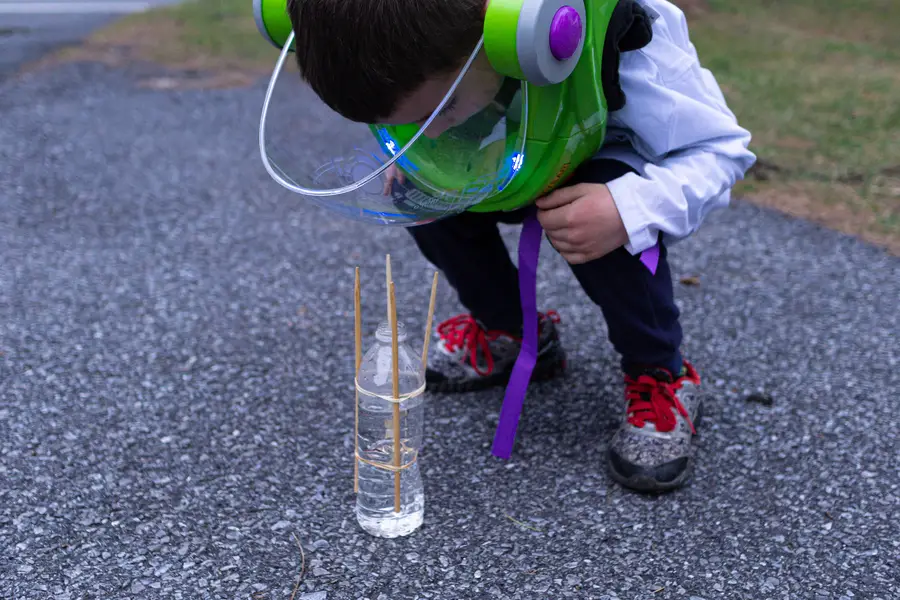
Materials needed:
- Recycled plastic bottle
- Baking soda
- Fins or a stand for the bottle
Important – you’ll definitely want to do this experiment outside with enough space for your rocket to shoot skyward and come back down.
- Grab an empty plastic bottle
- fashion some fins from sturdy cardboard, or build some legs for the rocket. We simply used 3 chopsticks held in place by a rubberband to support the rocket for launch.
- Add 2-3 tablespoons of baking soda into the plastic bottle.
- Pour vinegar into the bottle until it’s about 1/3 full.
- Quickly insert a cork into the opening of the bottle.
- Flip the bottle upside down so the cork is on the bottom and the rocket is resting on the fins or support.
- Place the bottle on a flat surface, step back, and watch it launch!
The reaction between baking soda and vinegar produces carbon dioxide gas, which creates pressure inside the corked bottle. This pressure builds up until it’s strong enough to push the cork out of the opening, propelling the bottle upwards. The fins at the bottom of the bottle provide stability and keep the rocket flying straight.
Check this out and more in our post on experiments with plastic bottles.
Explore the properties of acids and bases
Mix different amounts of vinegar and baking soda to see how the strength of the acid or base affects the reaction. You can also try using different types of vinegar (such as apple cider vinegar or white vinegar) to see how they compare.
As you make small tweaks, note the effects of each. Remember to use the scientific method and make a hypothesis before testing it!
Invisible Ink with Vinegar and Baking Soda
You can use the leftover mixture form one of the above experiments as invisible in!
- White paper
- Vinegar & Baking Soda Mixture
- Paint brush or Q-tip
- Candle or light bulb
Follow these steps:
- In a bowl, mix equal parts of baking soda and water until the baking soda is fully dissolved. (Or use the leftover solution from one of the experiments above.)
- Dip a paint brush or Q-tip into the baking soda mixture and use it to write a secret message or draw a picture on the paper.
- Allow the paper to dry; the baking soda mixture will dry clear and the message will be invisible.
- To reveal the message, hold the paper close to a candle or light bulb.
Make a Ball
Combine a small amount of vinegar and a larger amount of baking soda in a bowl. Slowly add cornstarch until the mixture forms a dough-like consistency. Roll the dough into a ball and watch as it bounces. (Don’t expect it to be super ball level bouncy; it’s more of an experiment than a toy.)
- Measuring spoons
- Spoon for mixing
- Surface for rolling the dough
- Measure out 1 tablespoon of vinegar and 4 tablespoons of baking soda.
- Add the vinegar to a bowl.
- Slowly add the baking soda to the bowl while stirring continuously. This will create a foaming reaction.
- Continue stirring until the mixture stops foaming and becomes a paste.
- Slowly add cornstarch to the mixture while stirring until it forms a dough-like consistency.
- Remove the dough from the bowl and knead it with your hands until it becomes smooth.
- Roll the dough into a ball.
Science involved: When vinegar (acetic acid) and baking soda (sodium bicarbonate) are mixed together, they undergo a chemical reaction that produces carbon dioxide gas. This gas gets trapped in the dough-like mixture formed by adding cornstarch, causing the mixture to expand and become bouncy.
The carbon dioxide gas produced creates bubbles in the dough-like mixture, making it bouncy. The more baking soda you add, the more carbon dioxide gas is produced, resulting in a bigger and bouncier ball. The cornstarch helps to bind the ingredients together and create a dough-like consistency.
Note: if you’ve done a volcano kind of experiment, you can make further use of that mixture by slowly adding the corn starch to it until it’s doughy enough to shape into a ball.
Wrap Up – Vinegar Experiment with Baking Soda
This reaction is at the core of many classic science experiments, and it’s one of our favorites. The key ingredients are easily found in most kitchens as the setup is easy. With a few variations, you can use this for fun seasonal experiments and demonstrate several different science and chemistry concepts.
Don’t just dump the mixture when you’re done. A cup of vinegar and baking soda can be an effective cleaning agent! (Just don’t clean anything that food coloring may stain.)
Check out our STEM challenges with household products for more quick and easy experiments for kids, and check out our kitchen science experiments!
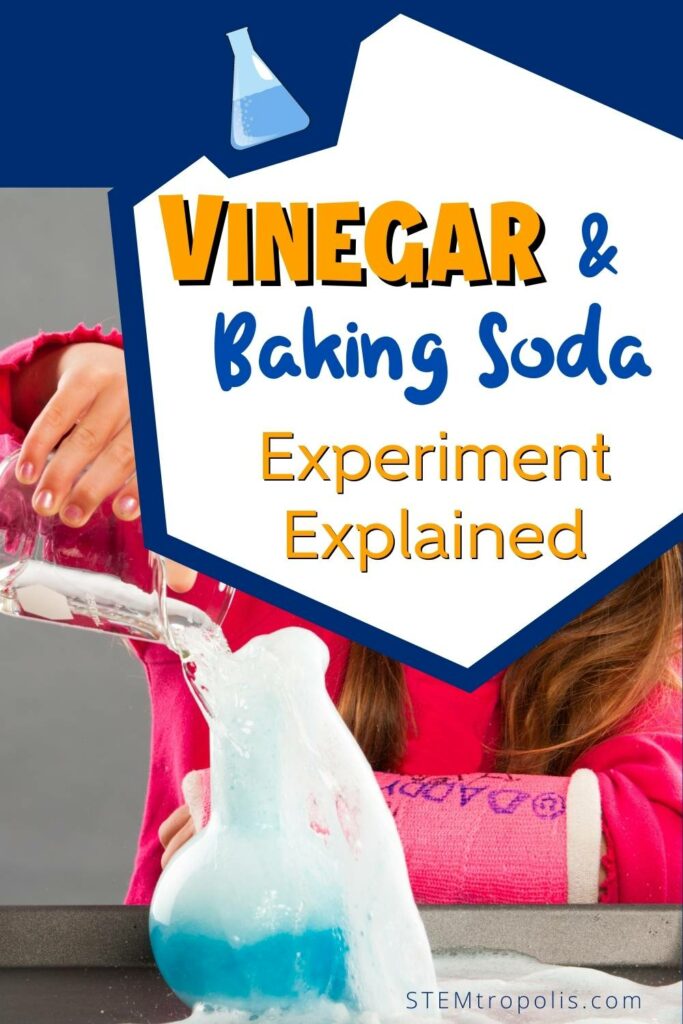
About the author
hevanmiller
Latest Posts
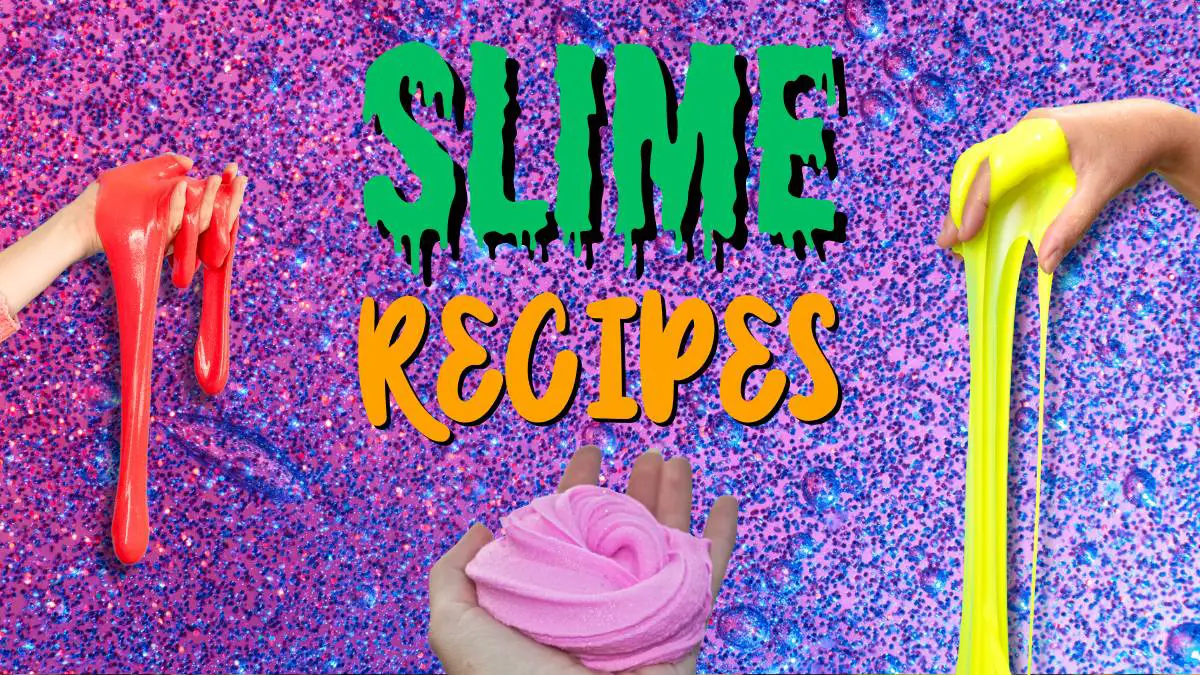
Slime Recipes and Variations: Different Types of Slime
Spread the loveSlime is a popular science experiment and sensory activity, and it’s easy to see why—it’s stretchy, squishy, and endlessly fun to play with! But did you know that there’s a whole world of different types of slime, each with its own unique texture, feel, and even special effects? We’ve got a collection of…

Slime Science Fair Project Ideas & Experiments
Spread the loveIt’s hard to land on a fun project for science fairs. Slime is always a winning idea. From chemistry to physics, slime provides endless opportunities to explore how materials interact, change, and behave under different conditions. There’s plenty of ideas to make slime the perfect science topic for a hands-on, engaging science project…
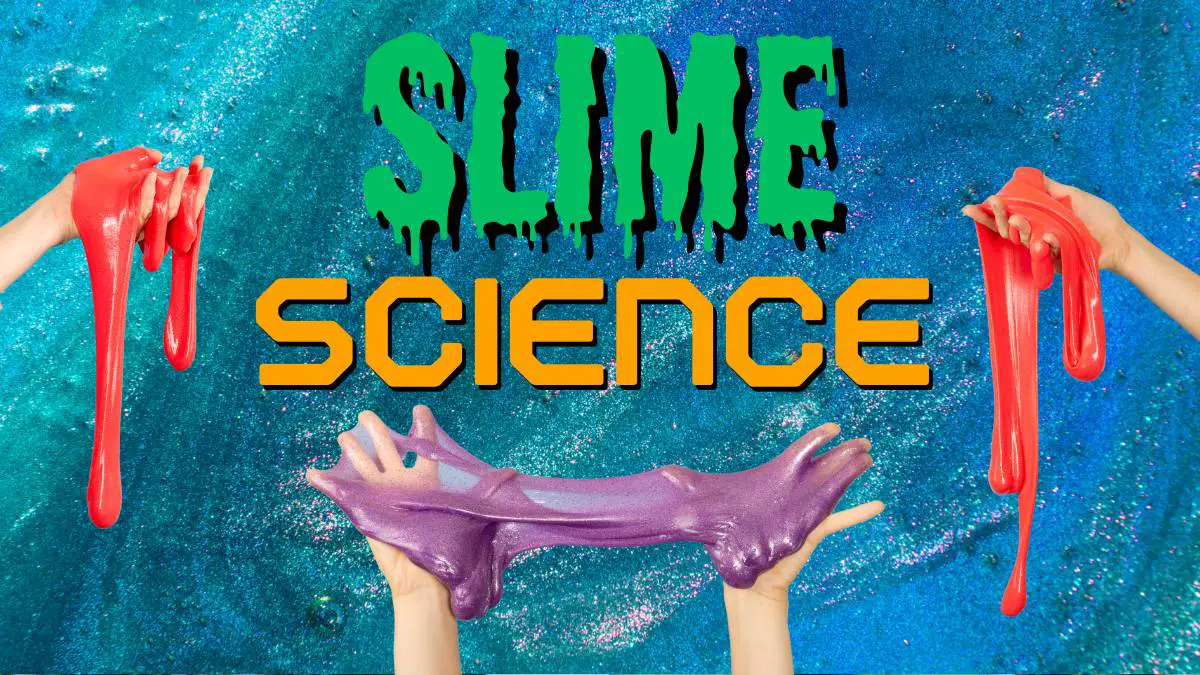
The Science of Slime: What makes Slime work?
Unlock the gooey secrets of slime! Learn the science behind how simple ingredients create slime, and learn how to make your own.

Learn about Reactions with This Vinegar and Baking Soda Experiment
Take a peek in your pantry. Do you have baking soda and vinegar? If so, you and your kids have the basic supplies for a bubbly science experiment!
These two products are staples in many households because they are essential cooking ingredients. , Baking soda helps baked goods rise, and a pinch or two will balance the acidity in dishes like tomato soup. Vinegar is a common ingredient in salad dressings and sauces, and a splash will elevate any dish in need of a bright, tangy flavor.
But can you mix vinegar and baking soda together? You sure can—and the result is a wonderful at-home science experiment. Vinegar and baking soda create a very effective cleaner for dishwashers, washing machines, clogged sinks, and even tile grout because of the chemical reaction that occurs when the two substances interact. You can harness this same reaction for an exciting chemistry activity!
The Science behind the Reaction
A baking soda and vinegar reaction is simple and safe for budding scientists of all ages. Older children may be curious about why the reaction occurs—here’s the rundown:
When combined, baking soda and vinegar undergo an acid-base reaction. Acids and bases are aqueous solutions (meaning they’re substances dissolved in water) that exist at opposite ends of the pH (potential of hydrogen) scale, which spans from 0 to 14. Acids measure between 0 and 7 and bases measure between 7 and 14, while a pH of 7 indicates a neutral substance. In simple terms, bases have the potential to gain hydrogen ions (an ion is a type of atom, one of the tiny building blocks that make up all matter), while acids have the potential to donate hydrogen ions to another substance.
Baking soda, or sodium bicarbonate, has a pH level of 9, making it a base. Vinegar, which is acetic acid dissolved in water, has a pH level of 2–3, making it an acid. , Baking soda is made up of sodium, hydrogen, carbon, and oxygen atoms. Vinegar is made up of hydrogen, carbon, and oxygen atoms.
When you mix baking soda and vinegar together, two hydrogen atoms move from the vinegar to the baking soda to create a salt called sodium acetate. The remaining atoms create a new acid—but it breaks down quickly into water and carbon dioxide gas.

It’s Time for an Experiment
Your kids can witness an acid-base chemical reaction right in your kitchen. This baking soda experiment for kids combines vinegar and baking soda, then uses the resulting carbon dioxide gas to inflate a balloon. This same reaction is behind science projects like fizzy potions and DIY volcanoes .
Children of all ages can participate in every step of this experiment, but younger kids may need help from an adult. You know your kid scientists’ abilities best!
Vinegar and Baking Soda Experiment
- ⅓ cup baking soda
- 1 cup white vinegar
- 1 empty plastic water or soda bottle
- 1 uninflated balloon
- 1 funnel
- Use the funnel to fill the uninflated balloon with baking soda. Kids can help pour the baking soda while an adult holds the funnel and balloon.
- Pour the vinegar into the empty plastic bottle. Fit the opening of the balloon over the mouth of the bottle, trying not to spill any baking soda out of the balloon.
- Once the balloon is securely attached to the bottle with no gaps for air to escape, lift the balloon and let the baking soda fall into the vinegar below.
- Watch as the baking soda and vinegar react—the mixture will bubble and fizz. As the reaction takes place, the balloon should begin to expand and fill with carbon dioxide gas!
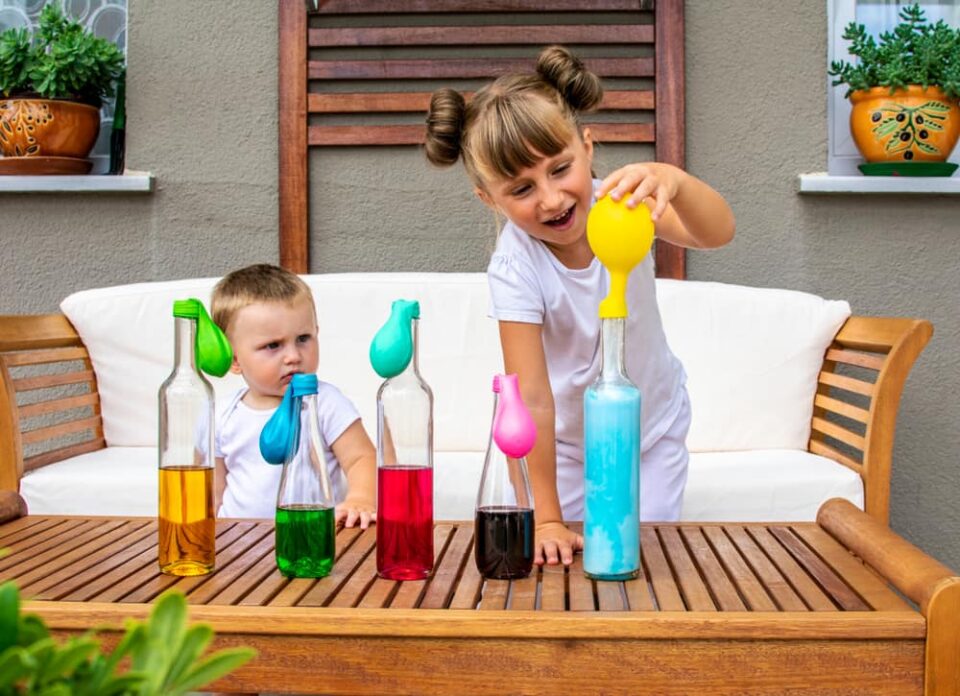
Using the Scientific Method
The balloon experiment is an excellent way to show your children the wonders of chemistry from the comfort of home. You can build on their learning by teaching them to follow the scientific method. This process is what scientists around the world use to construct and test their hypotheses (what they think will happen in an experiment).
Help your children navigate the following steps:
- Identify a problem or question: Ask your kids, “What do you think will happen to the balloon when we combine vinegar and baking soda?”
- Form a hypothesis : Encourage your children to guess how the vinegar and baking soda will react—and how that reaction will affect the balloon. Help them frame their hypothesis using the “if _____, then _____” format. For example: If the baking soda and vinegar mix, then bubbles will form and the balloon will expand.
- Conduct the experiment : Follow the steps in the experiment above to test their hypotheses.
- Collect and analyze the results: Help your kids monitor how the experiment plays out. Older children can make notes, while young ones may want to take photos or draw pictures of the experiment.
- Provide a conclusion: Ask your kids if their hypotheses were correct. If they were, great! If not, ask them how the experiment differed from what they expected. Remember: Science is all about making wrong guesses and learning from them. Help your young chemists understand that an incorrect hypothesis is just as good as a correct one.
You and your kids can apply the scientific method to all kinds of at-home science experiments. There are plenty of family-friendly activities to grow your children’s interest in chemistry. For example, you could test whether a substance is acidic or basic using cabbage and water , or using carbon dioxide gas to create a miniature “snowstorm.”
If your kids have a passion for experiments, sign them up for a science-based subscription box from Little Passports. The Science Junior box , designed for five-to-eight-year-olds, helps early elementary schoolers explore the wonders of science firsthand. Science Expeditions teaches children ages eight and up about more advanced scientific topics, such as aerodynamics and solar energy. Each month you’ll receive a box full of activities and discoveries to help your budding scientists flourish and grow.
Get Free Activities and Exclusive Offers
Sign up for our newsletter:
Blog Categories
- Craft & DIY
- World Holidays
Watch the Video!
Recent Posts
- Celebrate Your Daughter with This Japanese Girls’ Day Craft
- Enjoy a Fun-Filled Day with 10 Non-Screen Activities for Kids
- Spinning Science: How to Make a Tornado in a Bottle
- These Cute Easter Bunny Crafts Are a Hopping Good Time
- 3 Adorable DIY Gifts for Your Kids’ Favorite Teachers

7 Fizzy Baking Soda and Vinegar Science Experiments
This post may contain affiliate links.
Sharing is caring!
There is something about baking soda and vinegar science experiments that just never gets old. Kids of all ages enjoy these activities, but in my experience, little ones love them the most. They get so excited when they watch the baking soda and vinegar reaction!
When my kids were little I got into the habit of buying large containers of baking soda and white vinegar. These supplies are pretty inexpensive, especially when purchased in bulk. You might not want to use them in food prep after a while, but they are always good for science experiments.
Baking soda (sodium bicarbonate) and vinegar (water and acetic acid) form carbon dioxide gas when they are mixed together.
These easy science experiments are sure to be a hit! Creating an acid-base reaction is a fun way to learn about chemical reactions.
Baking Soda and Vinegar Science Experiments

Tip – I recommend doing all of the vinegar and baking soda science experiments on a baking sheet or outside. The fizzy reactions can get messy quickly!

Classic Volcano
Making a volcano is a classic science experiment for kids. This activity can fit in with a science lesson about chemical reactions, but it can also be a great volcano demonstration in a lesson about volcanos.
You will need:
- Container to hold the baking soda
- Baking soda
- Playdough or clay (if you want to form a classic volcano shape)
First, gather all of your materials. You can use pretty much any container to make the volcano. I used a beaker from my science cabinet, but you could use a drinking glass, a mason jar, a clean can, etc. I have even seen people make a big baking soda and vinegar volcanos using sand buckets! (Definitely do that outside for easy cleanup.)
I recommend putting the volcano in a glass casserole dish to contain the mess.
If you want to form the classic volcano shape, use playdough or clay to add a slope to your container. You can also paint it if you want. Let this harden and dry before adding baking soda or vinegar.
When your volcano is ready, sprinkle baking soda into your container. Different volcanos will need different amounts of baking soda. If you have a small container you will just need a little. If you use a large container you will need a lot.
When everyone is ready, pour the vinegar onto the baking soda. The fizzy chemical reaction happens pretty much instantly.

Fizzy Dinosaur Eggs
This fizzy dinosaur eggs activity from Kim at TheBestIdeasForKids.com is going to be a hit with any young children who love dinosaurs. Kids can help prepare the baking soda eggs and then use the vinegar to make them ‘hatch’ or an adult can prepare the eggs ahead of time.
- Food coloring
- Small plastic dinosaurs (or whatever you want inside of the eggs)
- Squirt bottle or dropper
Get the full fizzy dinosaur egg directions .
Drop Painting
I loved setting my kids up with this activity when they were toddlers – early elementary. It was my go-to activity when I needed them to be engaged at the kitchen table so I could supervise them while cooking. They had a great time and I was able to cook without little hands helping.
- Baking tray or dish
- Cups – one for each color
- Different colors of food coloring
- Dropper or pipette – one for each color
To set up this activity, add a layer of baking soda to a baking dish. Then add vinegar to small cups. I used an assortment of recycled glass jars. Add a few drops of food coloring to each cup. Kids can help mix primary colors to create secondary colors. Put a pipette or dropper in each cup.
Now kids can use the pipettes to drop colored vinegar onto the baking soda. Everywhere that a drop of vinegar hits the baking soda kids will see bubbles in the color of the vinegar.
Some kids like to make a picture using the baking soda as a temporary canvas. Other kids just enjoy the process. Either way, they are having fun experimenting with baking soda and vinegar. This sort of activity when kids are young lays a foundation for understanding chemical reactions when they are older.

Hot ice seems like an oxymoron, but it is actually a really cool science experiment using baking soda and vinegar. This activity has a few more steps than some of the other ideas, but kids will be delighted with the result.
- Baking Soda
- Glass measuring cup
- Glass pie plate
- Refrigerator
Get the full directions for hot ice from PlaydoughtoPlato.com .
Hidden Colors
This hidden colors activity is similar to the vinegar drop painting activity. It uses the same basic supplies, but the order is different.
- Mini-muffin tin
- Vinegar in a cup
- Dropper or pipette
Put a few drops of food coloring in each mini-muffin tin well. Cover it with a thin layer of baking soda. You want enough baking soda to cover the food coloring, but not enough to fill up the muffin tin. When it is ready, kids shouldn’t be able to tell what color is in which spot.
Pour vinegar into a cup and give your child a dropper or pipette.
Kids can slowly add drops of vinegar to each well of baking soda until they can see the color mix in with the carbon dioxide bubbles.

Exploding Bag
I think most kids go through a phase where they like to watch things explode. In my house that happened in the late elementary and early middle school years.
This baking soda and vinegar activity will make kids who love explosions happy.
I think it is a good idea to do this activity outside because it can get messy! The aftermath of a baking soda and vinegar explosion can feel gritty so it is helpful if it is done on a driveway so it can be hosed off.
- Plastic bag with a zip seal
- Permanent markers (optional)
Get the full directions for making an exploding bag at MomBrite.com .
Inflate a Balloon
Watching fizzy bubbles and explosions can be fun, but this baking soda and vinegar experiment helps kids understand that chemical reactions can be useful. They will attempt to inflate a balloon using baking soda and vinegar. Now, this certainly isn’t the most efficient way to blow up a balloon, but it gets kids thinking about science as useful.
- Plastic bottle
Get the full directions at HappyBrownHouse.com .
I hope your kids enjoyed these simple science experiments! Once they have tried a few of these simple baking soda and vinegar activities, let them try making changes to see if the results change. Maybe they can try using lemon juice instead of vinegar and see what happens!
Check out these other science activities for kids!
- How to Grow a Germ Farm
- Rock Cycle Activities for Middle School
- Helpful Science Vocabulary Activities
As an Amazon Associate I earn from qualifying purchases.
Welcome! My name is Jennifer. I am a teacher at heart. Before my children were born I was a public school teacher. Now, I am a homeschooling mom of two.
Suggested keywords:
- Science Experiments
- DIY Experiments
- School Experiments
- Kids Experiments
- Lab Experiments
vinegar and baking soda experiment
The vinegar and baking soda experiment is a classic and exciting science activity that demonstrates a chemical reaction. Discover how to conduct this experiment step-by-step and understand the science behind it.
The vinegar and baking soda experiment is a classic and popular demonstration that showcases the fascinating chemical reaction that occurs when an acid and a base interact. By combining vinegar (acetic acid) and baking soda (sodium bicarbonate), we can observe an exciting display of bubbling and fizzing. This experiment not only captivates the imagination but also serves as a valuable educational tool, allowing us to explore the properties of acids and bases in an interactive and engaging manner.
To conduct this experiment, you will need a few basic materials: baking soda, vinegar, a clear plastic bottle or glass jar, a funnel (optional), and a balloon (optional).
Let's walk through the steps of the experiment:
- Begin by selecting a clear plastic bottle or glass jar to serve as the container for the reaction. It's helpful to use a clear vessel, as it allows for better observation of the reaction.
- If desired, use a funnel to carefully pour a small amount of baking soda into the bottle, filling it to about one-quarter of its capacity. The funnel helps to prevent any spillage or mess.
- Slowly pour vinegar into the bottle, being cautious not to fill it to the brim. Leave some space at the top to accommodate the reaction that will take place. As the vinegar comes into contact with the baking soda, the magic begins.
- Observe the reaction as the vinegar and baking soda interact. Almost immediately, you will witness a flurry of bubbles and fizzing. This effervescent display is a result of the chemical reaction occurring between the acetic acid in the vinegar and the sodium bicarbonate in the baking soda.
- For an added interactive element, you can stretch a balloon over the top of the bottle or jar before pouring in the vinegar. As the carbon dioxide gas is generated during the reaction, it will inflate the balloon, creating a visual representation of the gas production.
The chemical reaction that transpires between the vinegar and baking soda can be explained by the following equation:
CH3COOH (acetic acid) + NaHCO3 (sodium bicarbonate) → CO2 (carbon dioxide) + NaC2H3O2 (sodium acetate) + H2O (water)
The reaction between the acid (vinegar) and the base (baking soda) produces carbon dioxide gas, which manifests as bubbles. Simultaneously, sodium acetate and water are formed as byproducts of the chemical reaction.
This experiment serves as an excellent educational tool, particularly for teaching children about chemical reactions and the properties of acids and bases. It provides a hands-on experience that allows them to witness the exciting transformation and understand the principles at play.
By engaging in the vinegar and baking soda experiment, children can develop a deeper appreciation for the world of chemistry. They can learn about the concept of chemical reactions, how different substances interact, and the role of acids and bases in these processes. Furthermore, the visual effects of bubbling and the inflation of the balloon make the experiment even more captivating and memorable.
However, it is important to note that while this experiment is safe and enjoyable, caution should always be exercised. Adult supervision is advised, especially when working with young children. It's crucial to handle the materials responsibly, avoid ingestion or contact with eyes, and clean up any spills promptly.
In conclusion, the vinegar and baking soda experiment provides an exciting opportunity to explore the chemical reaction between an acid (vinegar) and a base (baking soda). Through the combination of these two substances, we witness a captivating display of bubbling and fizzing, accompanied by the production of carbon dioxide gas, sodium acetate, and water. This experiment serves as an interactive and educational tool, allowing children to gain insights into the world of chemistry, understand the properties of acids and
- Share this :
Mohamed Aslam
Related posts, water experiments, most popular, how to make waterproof bag, how to make slime at home, how to mix soft drink and baking soda: a refreshing experiment, how to send a secret message like a secret agent, to our newsletter.
- Grades 6-12
- School Leaders
Give Students a Voice in This Digital Storytelling Competition!
Every product is independently selected by our team of teacher-reviewers and editors. Things you buy through our links may earn us a commission.
How To Make a Baking Soda Volcano With Free Observation Sheet
This experiment will have kids erupting with applause!
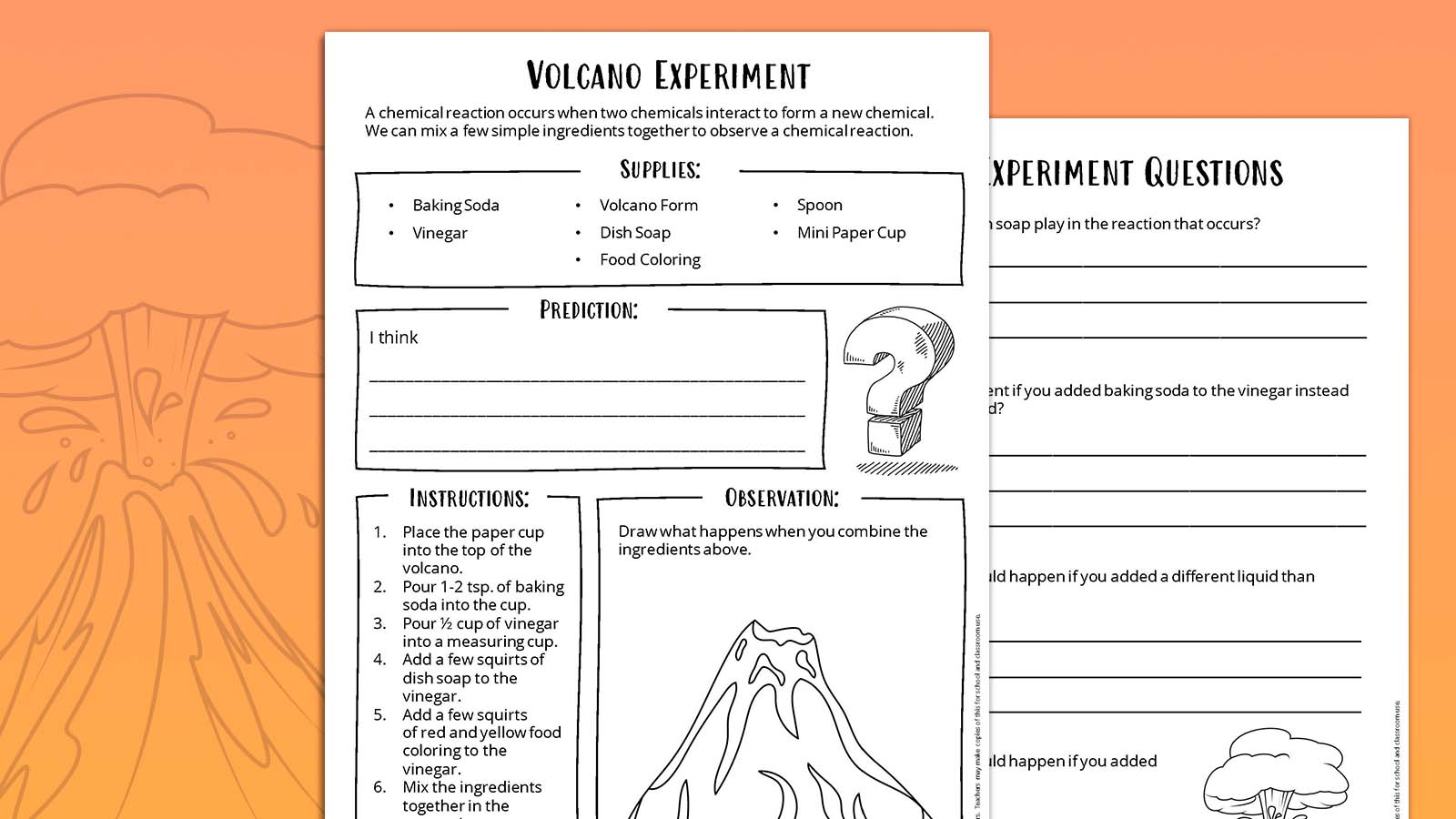
The classic baking soda volcano experiment has been entertaining kids (and adults) of all ages for decades. But it’s more than just a lot of fun. This experiment also teaches kids about simple chemical reactions and physical properties. The best part? It’s easy to do and uses only a few basic ingredients. Read on to see how to conduct the baking soda volcano experiment, and fill out the form on this page to grab your free recording sheet!
How does the baking soda volcano experiment work?
This experiment involves pouring vinegar mixed with dish soap into a small amount of baking soda. The baking soda acts as a base while the vinegar is an acid. When the base and the acid come together, they create an endothermic reaction that produces carbon dioxide. The dish soap helps to create the foaming effect as the “lava” pours out of the volcano.
What does the baking soda volcano teach?
The baking soda volcano experiment is a great way to demonstrate a chemical reaction between an acid and a carbonate. When the carbonate (found in the baking soda) is exposed to the acids (found in the vinegar), it creates a decomposition reaction that releases carbon dioxide as gas. While this experiment is an example of an acid-base reaction, it’s also a great simulation of a real volcanic eruption.
Is there a baking soda volcano video?
This video shows how to make a volcano erupt using ingredients you can probably find in your kitchen.
Materials needed
To do the baking soda volcano experiment, you will need:
- Baking soda
- Food coloring
- Mini Paper Cups
- Plastic Volcano Form
Our free recording sheet is also helpful—fill out the form on this page to grab it.
Baking soda volcano experiment steps:
1. to start, place a tiny paper cup into the hole at the top of the plastic volcano mold..
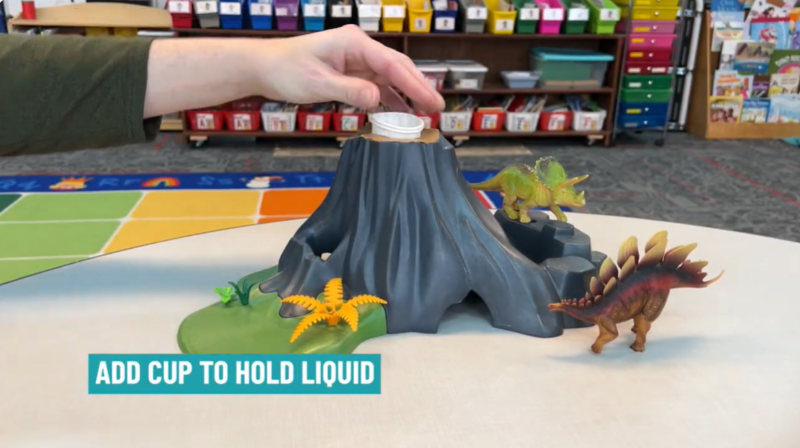
2. Once your volcano is set up, pour 1 to 2 teaspoons of baking soda into the paper cup.
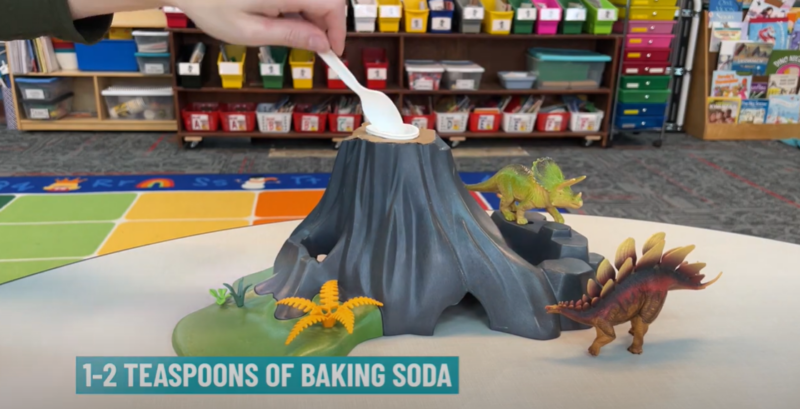
3. Next, add about a half cup of vinegar into a plastic measuring cup.
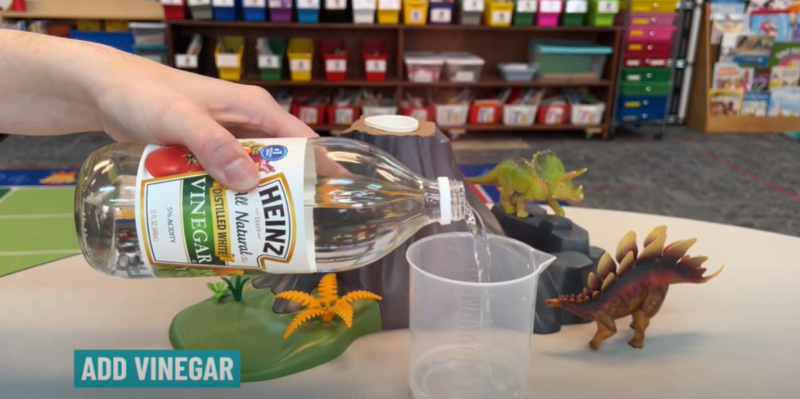
4. Add a few squirts of dish soap to the vinegar solution.
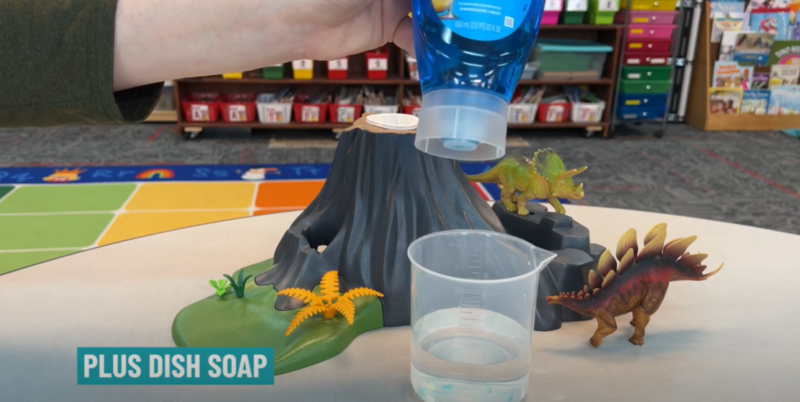
5. Add some squirts of red and yellow food coloring to the vinegar mixture.
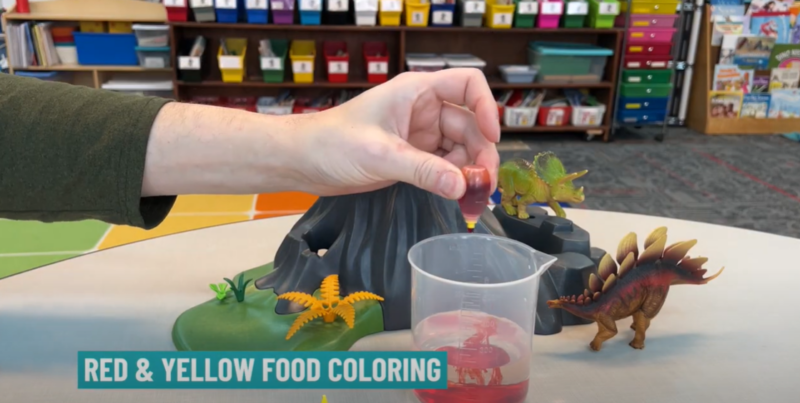
6. Use a plastic spoon to mix all the ingredients in the plastic measuring cup together.
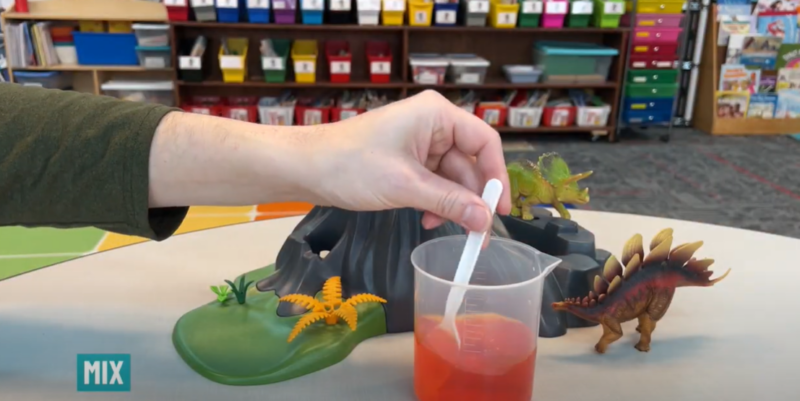
7. Pour the vinegar solution into the small paper cup at the top of the volcano.
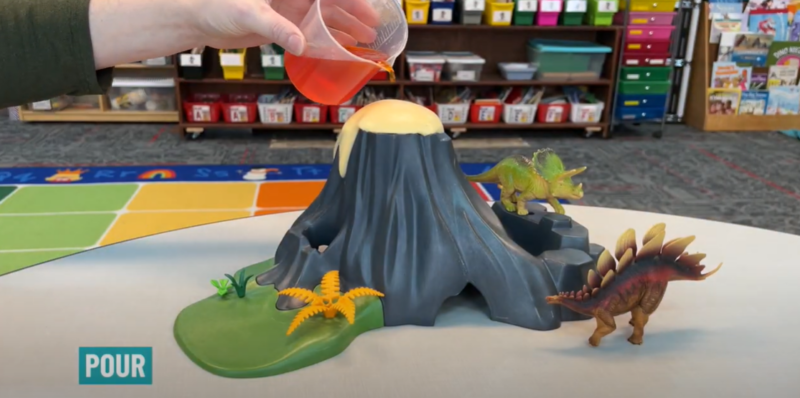
8. Finally, watch and enjoy the eruption!
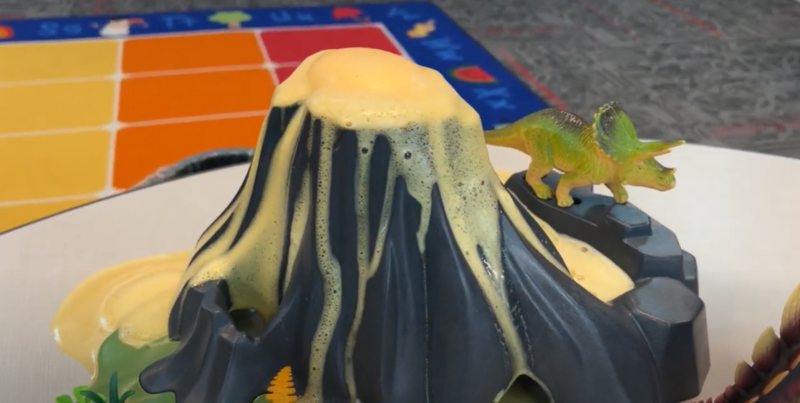
Grab our free baking soda volcano experiment worksheet
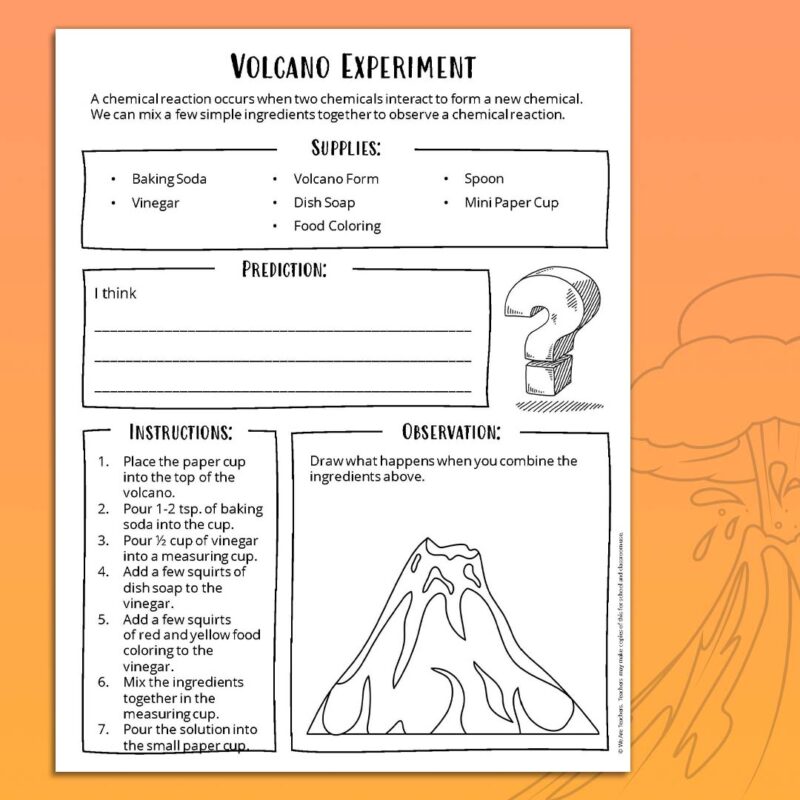
Fill out the form on this page to get your free worksheet. The worksheet asks kids to guess the correct order of the steps in the experiment. Next, kids must make a prediction about what they think will happen. They can use the provided spaces to draw what happens before and after they add the ingredients. Did their predictions come true?
Additional reflection questions
- What role does the dish soap play in the reaction that occurs?
- How would it be different if you added baking soda to the vinegar instead of the other way around?
- What do you think would happen if you added a different liquid than vinegar?
- What do you think would happen if you added more baking soda?
Can the baking soda volcano experiment be done for a science fair?
Yes! If you want to do this experiment for a science fair, we recommend switching up some of the variables. For example: Does the amount of baking soda matter? Does the type of dish soap? Form a hypothesis about how changing the variables will impact the experiment. Good luck!
Looking for more experiment ideas? Check out our big list of experiment ideas here.
Plus, be sure to subscribe to our newsletters for more articles like this., you might also like.
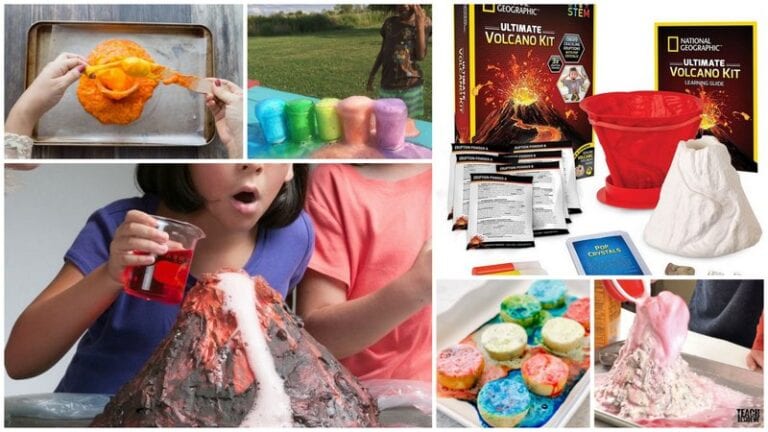
16 Red-Hot Volcano Science Experiments and Kits For Classrooms or Science Fairs
Kids will erupt with excitement! Continue Reading
Copyright © 2024. All rights reserved. 5335 Gate Parkway, Jacksonville, FL 32256

IMAGES
VIDEO
COMMENTS
With a few easily found materials, a little vinegar, and the familiar orange box of ARM & HAMMER™ Baking Soda, you can create quick STEM challenges that use math and demonstrate scientific reactions.
From creating bubbling volcanoes to exploring the properties of acids and bases, vinegar and baking soda offer fun opportunities for hands-on learning and experimentation. So grab a bottle of vinegar and a box of baking soda, and get ready to have some fun!
The Science behind the Reaction. A baking soda and vinegar reaction is simple and safe for budding scientists of all ages. Older children may be curious about why the reaction occurs—here’s the rundown: When combined, baking soda and vinegar undergo an acid-base reaction.
Baking soda (sodium bicarbonate) and vinegar (water and acetic acid) form carbon dioxide gas when they are mixed together. These easy science experiments are sure to be a hit! Creating an acid-base reaction is a fun way to learn about chemical reactions.
To conduct this experiment, you will need a few basic materials: baking soda, vinegar, a clear plastic bottle or glass jar, a funnel (optional), and a balloon (optional). Begin by selecting a clear plastic bottle or glass jar to serve as the container for the reaction.
This classic science experiment is always a favorite activity for kids. And it's easy to put together too! You only need baking soda, food coloring, water and vinegar. Kids will loving making this fizzy rainbow.
Baking soda is made up of tiny particles called molecules. Each molecule has three different elements: sodium, hydrogen, carbon, and oxygen. Something exciting happens when baking soda comes into contact with an acid, like vinegar! The acid (vinegar) and the base (baking soda) react.
Materials Needed. To do the baking soda and vinegar balloon experiment, you will need: A funnel; Approximately 1/2 cup of vinegar; Empty water bottle or similar container; Baking soda; Measuring spoon; Deflated balloon; Our free recording sheet is also helpful—fill out the form on this page to get it. Baking soda and balloon experiment steps: 1.
MATERIALS. white vinegar. baking soda. trays, cake pans, etc. pipettes (optional) liquid watercolors or food coloring. INSTRUCTIONS. Setup. First mix the white vinegar and liquid watercolors in clear jars, then add pipettes. Next, spread a layer of baking soda on a tray or cake pan.
Feb 28, 2024. The classic baking soda volcano experiment has been entertaining kids (and adults) of all ages for decades. But it’s more than just a lot of fun. This experiment also teaches kids about simple chemical reactions and physical properties. The best part? It’s easy to do and uses only a few basic ingredients.